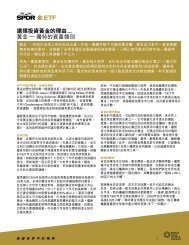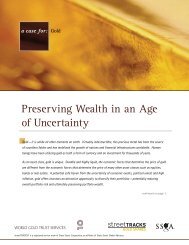Create successful ePaper yourself
Turn your PDF publications into a flip-book with our unique Google optimized e-Paper software.
Because gold tends to have little correlation with many assetclasses, it is a strong candidate for portfolio diversification.Unlike other assets typically considered diversifiers, gold’scorrelation to other assets tends to change in a way thatbenefits portfolio returns. For example, while gold correlation toUS equities is on average not statistically significant, it tends todecrease as US equities fall and increase when they rise.This behaviour is more evident when one compares thecorrelation of equities to gold and commodities in periods whenequity returns fall by more than two standard deviations fromzero (Chart 2). From December 1987 to December 2012, theaverage weekly-return correlation of the S&P 500 and theS&P <strong>Gold</strong>man Sachs Commodity Index was 0.16; while thiscorrelation changed to 0.41 in periods during which equityreturns rose by more than 2σ, it increased even more to 0.55when equities faltered. Put simply, in economic and financialdownturns, most industrial-based commodities and equitieshave tended to follow a similar pattern. On the other hand,history shows that gold’s correlation to equities became morenegative during these same periods. Between December 1987and December 2012, the average correlation between gold andthe S&P 500 stood at -0.04. In periods during which equityreturns rose by more than 2σ, the correlation turned positiveto 0.41, but when equities fell by more than 2σ, the correlationcoefficient dropped to -0.29. This is by no means a strongnegative correlation but it serves to exemplify the benefits thatgold can offer when managing the overall risk of a portfolio.Optimal allocations to goldThe performance of an investor’s portfolio is driven by itsindividual components and the interactions between theseassets. In previous studies, the World <strong>Gold</strong> Council has foundthat gold allocations are statistically significant and can improvethe efficiency of the portfolio. 8 Put simply, investors benefitby having a long-term positive exposure to gold, which can beadjusted up and down as a response to the macroeconomicenvironment and the risk aversion of investors.Optimal allocations to gold typically range between 2% and10% across multiple currencies (Chart 3) and are based onconservative expectations for gold returns – at either 0% or 2% inreal (inflation-adjusted) terms. 9 These ranges are a function of theportfolio composition and the desired level of volatility. In otherwords, gold’s appropriate weighting varies depending on whatother assets are held in the portfolio and the riskiness of thoseassets. In general, the riskier the portfolio, the higher the goldallocation. Further, in <strong>Gold</strong>: a commodity like no other, April 2011,we demonstrated that gold brings unique benefits to investorsin terms of portfolio efficiency and diversification that cannot bereplicated solely by an allocation to a commodity basket.Additionally, Oxford Economics found that 10 – through an analysison US-dollar-based assets – investors who are more concernedwith the prospect of a higher inflationary or a deflationaryenvironment benefit from higher average allocations togold (Chart 4).Chart 2: Long-term weekly-return correlation between equities, gold and commodities to S&P 500 during extreme moves*All S&P 500 returnsS&P 500 return less than -2σ-0.5 -0.25 0 0.25 0.5 0.75S&P 500 and gold ($/oz)S&P 500 and S&P GSCI1.0Correlation*Conditional correlations computed using weekly returns from December 1987 to December 2012.Source: Bloomberg, World <strong>Gold</strong> Council8 For more details see the following papers from the World <strong>Gold</strong> Council: <strong>Gold</strong>: hedging against tail risk, October 2010; <strong>Gold</strong>: a commodity like no other,April 2011; <strong>Gold</strong>: alternative investment, foundation asset, October 2011; <strong>Gold</strong> as a strategic asset for UK investors, July 2012; Optimal allocation to goldfor Japanese investors, July 2012; as well as those jointly published with New Frontier Advisors: <strong>Gold</strong> as a strategic asset, September 2006; and <strong>Gold</strong> as astrategic asset for European investors, December 2011.9 To find the optimal weights employed to construct different sample portfolios, we used Resampled Efficiency (RE) optimisation developed by Michaudand Michaud.10 Oxford Economics, The impact of inflation and deflation on the case for gold, July 2011.<strong>Gold</strong> <strong>Investor</strong> | Risk management and capital preservation










